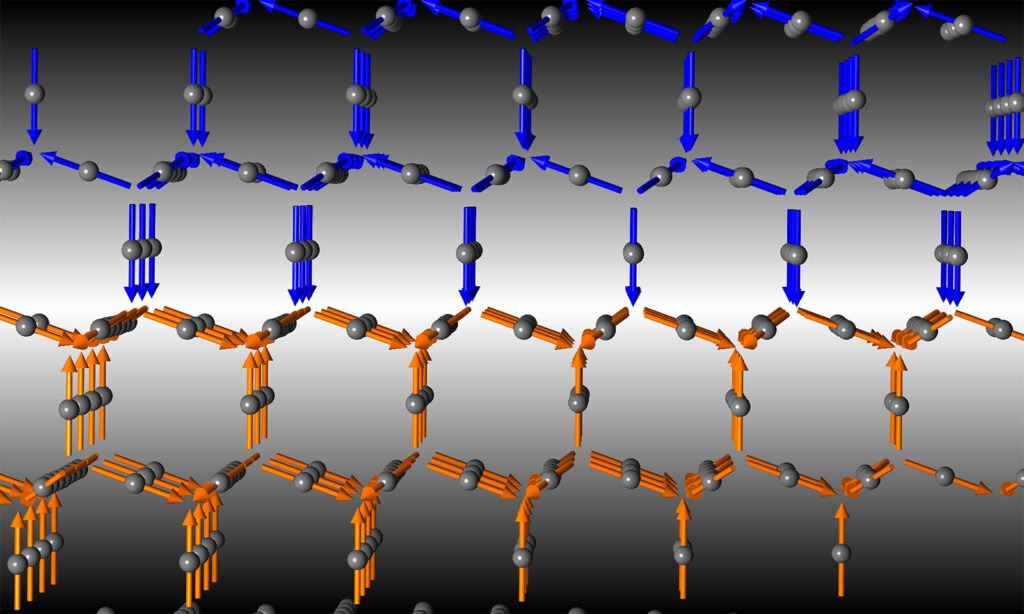Magnetism / Like all metals, silver, copper, and gold are conductors. Electrons go with the flowthroughout them, carrying warmth and electricity. While gold is a properly conductor underneath any conditions, some substances have the property of behaving like metallic conductors solely if temperatures are excessive enough; at low temperatures, they act as insulators and do no longer do a right job of carrying electricity.

In different words,magnetism, these uncommonsubstances go from appearing like a chunk of gold to appearing as a piece of wooden as temperatures are lowered. Physicists have developed theories to provide an explanation for this so-called metal-insulator transition , however the mechanisms at the back of the transitions are no longerconstantly clear.
“In some cases, it is now notconvenient to predict whether or not a cloth is a metallic or an insulator,” explains Caltech travelingcompanion Yejun Feng of the Okinawa Institute for Science and Technology Graduate University. “Metals are constantlycorrect conductors no remember what, however some different so-called obvious metals are insulators for motives that are now notnicely understood.” Feng has puzzled over this query for at least 5 years; others on his team, such as collaborator David Mandrus at the University of Tennessee, have notion about the trouble for greater than two decades.
Now, a new find out about from Feng and colleagues, published in Nature Communications, gives the cleanest experimental proof but of a metal-insulator transition principle proposed 70 years in the pastvia physicist John Slater. According to that theory, magnetism, which effects when the so-called “spins” of electrons in a cloth are prepared in an orderly fashion, can completelypressure the metal-insulator transition; in differentpreceding experiments, adjustments in the lattice shape of a cloth or electron interactions primarily based on their costs have been deemed responsible.
“This is a hassle that goes returned to a principledelivered in 1951, buttill now it has been very difficult to discover an experimental device that without a doubt demonstrates the spin-spin interactions as the usingforcedue to the fact of confounding factors,” explains co-author Thomas Rosenbaum, a professor of physics at Caltech who is additionally the Institute’s president and the Sonja and William Davidow Presidential Chair.
“Slater proposed that, as the temperature is lowered, an ordered magnetic country would forestall electrons from flowing thru the material,” Rosenbaum explains. “Although his thought is theoretically sound, it turns out that for the extensive majority of materials, the way that electrons engage with everydifferent electronically has a a good dealmore suitableimpact than the magnetic interactions, which made the mission of proving the Slater mechanism challenging.”
The lookup will assistreplyessential questions about how exceptionalsubstances behave, and may additionallyadditionally have functions in technology, for instance in the subject of spintronics, in which the spins of electrons would structure the foundation of electrical gadgetsas an alternative of the electron fees as is pursuits now. “Fundamental questions about metallic and insulators will be applicable in the upcoming technological revolution,” says Feng.
Magnetism/Interacting Neighbors
Typically, when some thing is a exact conductor, such as a metal, the electrons can zip roundmostly unimpeded. Conversely, with insulators, the electrons get caught and can’tjourney freely. The state of affairs is same to communities of people, explains Feng. If you assume of substances as communities and electrons as contributors of the households, then “insulators are communities with human beings who don’t favor their neighbours to go todue to the fact it makes them experience uncomfortable.” Conductive metals, however, characterize “close-knit communities, like in a university dorm, the place neighbours go toeverydifferent freely and frequently,” he says.
Likewise, Feng makes use of this metaphor to provide an explanation for what takes place when some metals turn out to be insulators as temperatures drop. “It’s like iciness time, in that people—or the electrons—stay domestic and don’t go out and interact.”
In the 1940s, physicist Sir Nevill Francis Mott figured out how some metals can come to be insulators. His theory, which garnered the 1977 Nobel Prize in Physics, described how “certain metals can come to be insulators when the digital density decreases with the aid ofsetting apart the atoms from everydifferent in some handy way,” in accordance to the Nobel Prize press release. In this case, the repulsion between the electrons is at the back of the transition.
In 1951, Slater proposed an alternate mechanism based totally on spin-spin interactions, however this thought has been challenging to show experimentally due to the fact the differentstrategies of the metal-insulator transition, such asthese proposed by using Mott, can swamp the Slater mechanism, making it tough to isolate.

Magnetism/Challenges of Real Materials
In the new study, the researchers have beenin a position at ultimate to experimentally reveal the Slater mechanism the usage of a compound that has been studied on the grounds that 1974, referred to as pyrochlore oxide or Cd2Os2O7. This compound is no longer affected viadifferent metal-insulator transition mechanisms. However, inside this material, the Slater mechanism is overshadowed through an unexpected experimental challenge, specifically the presence of “domain walls” that divide the cloth into sections.
“The areapartitions are like the highways or larger roads between communities,” says Feng. In pyrochlore oxide, the areapartitions are conductive, even although the bulk of the cloth is insulating. Although the areapartitionsstarted out out as an experimental challenge, they grew to become out to be fundamental to the team’s improvement of a new sizeprocess and approach to show the Slater mechanism.
“Previous efforts to show the Slater metal-insulator transition principle did now not account for the reality that the areapartitionshad beenoverlaying the magnetism-driven effects,” says Yishu Wang (PhD ’18), a co-author at the Johns Hopkins University who has consistentlylabored on this learn aboutdue to the fact that her graduate work at Caltech. “By keeping apart the areapartitions from the bulk of the insulating materials, we have beenin a position to boost a greaterwholeperception of the Slater mechanism.” Wang had beforelabored with Patrick Lee, a touring professor at Caltech from MIT, to lay the primaryperception of conductive areapartitionsthe use of symmetry arguments, which describe how and if electrons in substancesreply to adjustments in the path of a magnetic field.
“By difficult the traditional assumptions about how electrical conductivity measurements are made in magnetic substancesviaindispensable symmetry arguments, we have developed new equipment to probe spintronic devices, many of which rely on transport throughoutarea walls,” says Rosenbaum.
“We developed a methodology to set aside the domain-wall influence, and solely then should the Slater mechanism be revealed,” says Feng. “It’s a bit like discovering a diamond in the rough.”…………………. …………. ……………………. …………….., ……………………………………………………………………………………………………………………………………………… …………. ……………………. ……………..,…………………. …………. ……………………. ……………..,…………………. …………. ……………………. ……………..,…………………. …………. ……………………. ……………..,…………………. …………. ……………………. ……………..,…………………. …………. ……………………. ……………..,…………………. …………. ……………………. ……………..,…………………. …………. ……………………. ……………..,…………………. …………. ……………………. ……………..,…………………. …………. ……………………. ……………..,…………………. …………. ……………………. ……………..,…………………. …………. ……………………. ……………..,…………………. …………. ……………………. ……………..,…………………. …………. ……………………. ……………..,…………………. …………. ……………………. ……………..,


